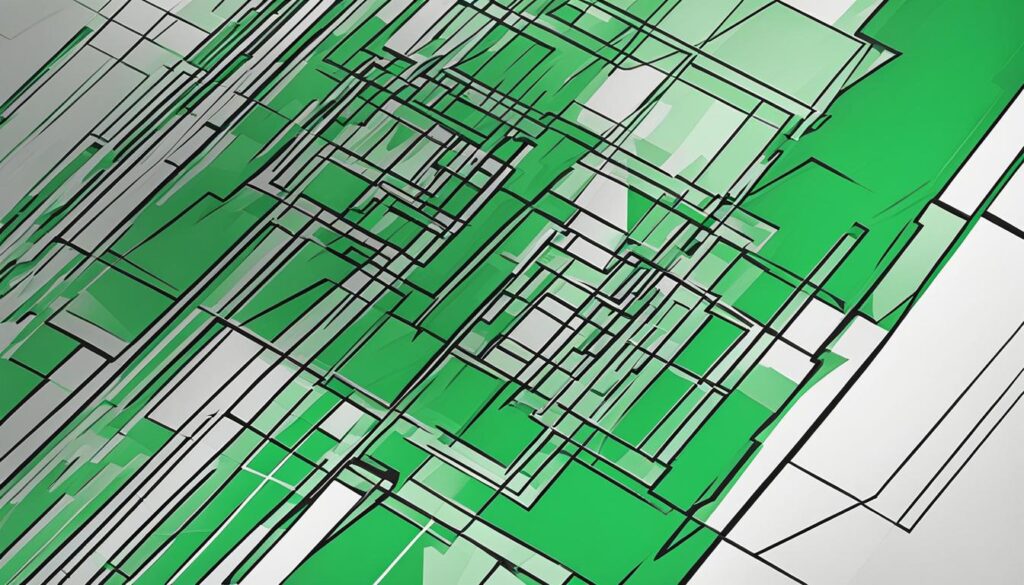Understanding crypto chart patterns is essential for successful crypto trading. These patterns provide visual representations of market behavior and can help traders make informed decisions and identify potential entry and exit points. By mastering technical analysis and recognizing chart patterns, traders can gain a competitive edge in the crypto market.
Key Takeaways:
- Crypto chart patterns are visual representations of market behavior.
- By understanding these patterns, traders can make informed decisions.
- Chart patterns help identify potential entry and exit points.
- Technical analysis is crucial for recognizing chart patterns.
- Mastering chart patterns can give traders a competitive edge.
The Importance of Chart Patterns in Crypto Trading
Chart patterns are a powerful tool in crypto trading, enabling traders to analyze market behavior and make predictions about future price movements. By studying these patterns, traders can gain valuable insights and make informed decisions when buying or selling cryptocurrencies. Understanding chart patterns is essential for successful trading, as it allows traders to identify potential entry and exit points and maximize profits.
Chart patterns provide visual representations of market trends and can reveal valuable information about supply and demand dynamics. By recognizing patterns such as triangles, rectangles, and head and shoulders formations, traders can predict potential price reversals and trend continuations. These patterns serve as reliable indicators of market behavior and help traders make informed decisions based on historical price movements.
By keeping a close eye on chart patterns, traders can also anticipate potential breakouts and breakdowns, allowing them to enter or exit trades at the most opportune moments. Whether it’s a bullish breakout from a symmetrical triangle or a bearish breakdown from a rectangle pattern, chart patterns provide traders with valuable signals to guide their trading strategies.
It is important to note that while chart patterns provide valuable insights, they should not be relied upon solely for trading decisions. Traders should also consider other factors, such as market fundamentals and news events, to ensure a comprehensive analysis. By combining multiple indicators and approaches, traders can increase their chances of making successful trades and navigating the volatile crypto market with confidence.
Table: Common Chart Patterns in Crypto Trading
| Pattern | Description | Implication |
|---|---|---|
| Bullish Triangle | Ascending triangle pattern with higher lows and a horizontal resistance line. | Potential continuation of an uptrend. |
| Bearish Triangle | Descending triangle pattern with lower highs and a horizontal support line. | Potential continuation of a downtrend. |
| Rectangle | Consolidation pattern with horizontal resistance and support lines. | Potential breakout in the direction of the prevailing trend. |
| Head and Shoulders | Pattern with a peak (head) flanked by two smaller peaks (shoulders). | Potential trend reversal from bullish to bearish or vice versa. |
Understanding chart patterns and their implications is crucial for successful crypto trading. By incorporating chart pattern analysis into their trading strategy, traders can make more informed decisions and increase their chances of profitable trades.
Types of Crypto Chart Patterns
Crypto chart patterns come in various forms and each one has its own unique characteristics and implications. By understanding these patterns, traders can gain valuable insights into market trends and make informed trading decisions. Let’s take a closer look at some of the most common types of crypto chart patterns:
Bullish Patterns
Bullish chart patterns indicate an upcoming price surge in the market. These patterns are often observed during an uptrend and suggest that buyers are outweighing sellers. One example of a bullish pattern is the cup and handle pattern, which resembles a cup with a handle and signals a potential bullish continuation.
Bearish Patterns
Bearish chart patterns, on the other hand, indicate an impending price drop in the market. These patterns are often observed during a downtrend and suggest that sellers are outweighing buyers. The head and shoulders pattern is a common bearish pattern that consists of a peak (the head) flanked by two smaller peaks (the shoulders), signaling a potential bearish reversal.
Triangle Patterns
Triangle patterns are characterized by converging trendlines and are often observed when the price consolidates before breaking out in a specific direction. There are three main types of triangle patterns: ascending triangles, descending triangles, and symmetrical triangles. Ascending triangles suggest a potential continuation of the bullish trend, while descending triangles indicate a potential continuation of the bearish trend. Symmetrical triangles, on the other hand, occur when the price swings in a sideways manner and can signal a potential breakout in either direction.
| Pattern | Characteristics | Implications |
|---|---|---|
| Cup and Handle | Resembles a cup with a handle, indicating a potential bullish continuation. | Signals a potential price surge and a buying opportunity. |
| Head and Shoulders | Consists of a peak (the head) flanked by two smaller peaks (the shoulders), indicating a potential bearish reversal. | Signals a potential price drop and a selling opportunity. |
| Ascending Triangle | Characterized by a flat top trendline and an ascending bottom trendline. | Suggests a potential continuation of the bullish trend. |
| Descending Triangle | Characterized by a flat bottom trendline and a descending top trendline. | Indicates a potential continuation of the bearish trend. |
| Symmetrical Triangle | Characterized by converging trendlines with no bias in either direction. | Signals a potential breakout in either direction. |
Mastering Triangle Crypto Chart Patterns
Triangle crypto chart patterns are highly popular among traders due to their ability to provide valuable insights into potential price movements. By understanding and interpreting these patterns, traders can effectively analyze market behavior and make informed trading decisions. In this section, we will explore the different types of triangle chart patterns: ascending triangles, descending triangles, symmetrical triangles, and wedge patterns.
Ascending Triangle
The ascending triangle pattern occurs during an upward trend and is characterized by a horizontal resistance line and an ascending support line. This pattern suggests a potential continuation of the bullish trend, indicating that buying pressure is gradually overpowering selling pressure. Traders closely monitor ascending triangles for a breakout above the resistance line, which may lead to a significant price surge.
Descending Triangle
On the other hand, the descending triangle pattern forms during a downtrend, with a horizontal support line and a descending resistance line. This pattern indicates a potential continuation of the bearish trend, signaling that selling pressure is gradually overpowering buying pressure. Traders analyze descending triangles for a breakout below the support line, which may result in a significant price drop.
Symmetrical Triangle and Wedge Patterns
Symmetrical triangles occur when the price swings in a sideways manner, forming converging trendlines. This pattern suggests indecision in the market, with buying and selling pressure evenly matched. Traders monitor symmetrical triangles for a breakout above or below the trendlines, which may indicate a potential price movement in the breakout direction.
Wedge patterns, both rising and falling, are variations of the symmetrical triangle pattern. Rising wedges have upward slanting trendlines and are bearish patterns, indicating a potential reversal of the current trend. Falling wedges, on the other hand, have downward slanting trendlines and are bullish patterns, suggesting a potential trend reversal to the upside. Traders analyze wedge patterns for breakout signals and trend reversals.

Bullish and Bearish Rectangle Chart Patterns:
In the world of crypto trading, rectangle chart patterns are essential tools for identifying potential price breakouts and trend reversals. These patterns are characterized by a period of consolidation within a specific range, forming a rectangular shape on the chart. Traders analyze bullish and bearish rectangles to make informed decisions about their trading strategies.
A bullish rectangle occurs during a downtrend and signals a potential upward breakout. This pattern suggests that buyers are gaining strength and preparing for a price surge. To confirm the bullish rectangle, traders typically look for a breakout above the upper boundary of the rectangle with increased trading volume.
On the other hand, a bearish rectangle forms during an uptrend and indicates a potential downward breakout. This pattern suggests that sellers are gaining momentum, leading to a possible price drop. Traders watch for a breakout below the lower boundary of the rectangle accompanied by significant selling volume to confirm the bearish trend.
| Bullish Rectangle | Bearish Rectangle |
|---|---|
 |
 |
Traders should exercise caution and use other technical indicators alongside rectangle patterns to confirm price movements and avoid false breakouts.
Understanding Pole Crypto Chart Patterns
In the world of crypto trading, pole chart patterns play a significant role in providing insights into potential price reversals. These patterns, which include the bullish flag, bearish flag, bullish pennant, and bearish pennant, can help traders identify profitable trading opportunities and make informed decisions.
The bullish flag pattern is characterized by a sharp price surge, followed by a consolidation phase where the price moves sideways in a flag-like pattern. This pattern suggests that the market is taking a breather before continuing the bullish trend. Traders often look for a breakout above the flag pattern to confirm the upward movement.
On the other hand, the bearish flag pattern is the mirror image of the bullish flag. It occurs after a significant downward price movement, followed by a period of consolidation in the form of a flag pattern. Traders watch for a breakout below the flag to confirm the continuation of the bearish trend.
“The bullish pennant pattern resembles the bullish flag pattern in terms of its structure. However, the consolidation phase takes the form of a symmetrical triangle. This pattern indicates a potential continuation of the previous uptrend and is often seen as a bullish signal.”
“Conversely, the bearish pennant pattern is similar to the bearish flag pattern but with a symmetrical triangle formation during the consolidation phase. Traders interpret this pattern as a potential continuation of the previous downtrend, signaling a bearish trend continuation.”

Bullish Flag Pattern Example
Table: Example of a Bullish Flag Pattern
| Date | Price |
|---|---|
| January 1 | 100 |
| January 2 | 120 |
| January 3 | 110 |
In the example above, the price experienced a sharp increase on January 2, forming the flagpole. Following the spike, the price entered a consolidation phase between January 2 and January 3, forming the flag pattern. Traders would monitor this pattern closely, looking for a breakout above the flag to confirm a potential continuation of the bullish trend.
The Importance of Head and Shoulders Chart Patterns in Crypto Trading
The head and shoulders pattern is a powerful chart pattern that often signals a trend reversal in the crypto market. This pattern consists of three peaks, with a central peak (the head) flanked by two smaller peaks (the shoulders). When this pattern forms after an uptrend, it suggests a bearish reversal, indicating that the price may start to decline.
The inverted head and shoulders pattern is the opposite of the traditional head and shoulders pattern. It forms after a downtrend and indicates a bullish reversal. This pattern consists of three troughs, with a central trough (the head) surrounded by two smaller troughs (the shoulders). Traders often see the inverted head and shoulders pattern as a signal that the price may start to rise.
“The head and shoulders pattern is a reliable indicator of trend reversals in the crypto market. When this pattern forms, it provides traders with valuable insights into potential price movements and helps them make informed trading decisions.” – Crypto Trading Expert
Analyzing Head and Shoulders Chart Patterns
To identify a head and shoulders pattern, traders look for several key characteristics. These include:
- The first peak (shoulder) is formed at the end of an upward trend.
- The subsequent trough (head) is higher than the first peak.
- The third peak (shoulder) is lower than the head.
- The neckline, which connects the lowest points of the troughs, acts as a support level.
Once the neckline is breached, it confirms the pattern, and traders may consider entering a trade in the direction of the reversal. It’s important to note that not all head and shoulders patterns lead to significant price reversals, so traders should use other indicators and analyze market conditions before making trading decisions.
| Head and Shoulders Pattern | Inverted Head and Shoulders Pattern |
|---|---|
 |
Unveiling Other Common Crypto Chart Patterns
In addition to the previously mentioned chart patterns, there are other common patterns that traders use to analyze price movements. These patterns, including falling wedges, rising wedges, double tops, and double bottoms, provide valuable insights into market behavior and can help traders make informed trading decisions.
A falling wedge is a bullish pattern characterized by zigzagging between converging trendlines. This pattern typically signals a potential upward breakout and indicates a bullish trend continuation. On the other hand, a rising wedge is a bearish pattern that is the inverse of a falling wedge. It suggests a potential downward breakout and indicates a bearish trend continuation.
“The falling wedge pattern is a powerful tool for technical analysis, indicating a potential bullish trend continuation. Traders closely monitor this pattern for breakout signals and potential profit opportunities.” – Crypto Expert
Double tops and double bottoms are chart patterns that often indicate trend reversals. A double top forms when the price reaches a high point, retraces, and then reaches a similar high point before reversing. This pattern suggests a bearish reversal. On the other hand, a double bottom forms when the price reaches a low point, bounces back, and then reaches a similar low point before reversing. This pattern indicates a bullish reversal.
| Chart Pattern | Description |
|---|---|
| Falling Wedge | Zigzagging between converging trendlines, bullish trend continuation |
| Rising Wedge | Zigzagging between converging trendlines, bearish trend continuation |
| Double Top | Reaching high points twice, bearish trend reversal |
| Double Bottom | Reaching low points twice, bullish trend reversal |
Traders carefully analyze falling wedges, rising wedges, double tops, and double bottoms to identify potential market trends and trading opportunities. By understanding and recognizing these chart patterns, traders can gain valuable insights into market behavior and make profitable trading decisions.
Detecting Market Manipulation with Chart Patterns
While understanding and utilizing chart patterns is crucial for successful crypto trading, it’s important to be aware of the potential for market manipulation. One such pattern associated with market manipulation is the Bart Simpson pattern. Although more of a meme than a real chart pattern, the Bart Simpson pattern refers to a sudden and sharp price movement followed by a quick reversal, resembling the iconic hairstyle of the cartoon character. Traders should exercise caution when encountering this pattern and use other indicators alongside chart patterns to confirm price movements and avoid false breakouts.
Market manipulation can distort the signals provided by chart patterns, leading to misguided trading decisions. It’s essential for traders to develop a comprehensive understanding of chart pattern signals and apply them in conjunction with other technical analysis tools. By combining multiple indicators, traders can reduce the risk of falling prey to manipulative market behaviors.
Recognizing market manipulation and understanding its potential impact on chart patterns can help traders make more informed trading decisions. Traders should remain vigilant and stay updated on market news and events that may contribute to manipulation attempts. By maintaining a critical mindset and applying thorough analysis, traders can navigate the crypto market with increased confidence.
Chart Pattern Signals: A Key to Accurate Analysis
Chart pattern signals are essential for accurate analysis and successful trading. These signals provide valuable insights into potential price movements and trend reversals. Traders can leverage various chart patterns, such as bullish and bearish patterns, to anticipate market behavior.
Also Read:- Unlock The Digital World With Our Crypto Voucher Options!
However, it’s important to note that chart patterns alone are not foolproof indicators. They should be used in combination with other technical analysis tools and market research to validate trading decisions. By considering a wide range of factors and cross-referencing different signals, traders can enhance their understanding of the market environment and make more informed decisions.
Conclusion
As we conclude this crypto trading guide, it is evident that understanding chart patterns is crucial for success in the crypto market. By analyzing these patterns, traders can gain valuable insights into market behavior and make informed trading decisions. Whether it’s identifying potential entry and exit points or managing risks effectively, chart patterns play a vital role in a trader’s strategy.
By incorporating chart patterns into their trading strategies, traders can increase their chances of profitability. These patterns provide visual representations of market trends, allowing traders to spot potential trade opportunities and make calculated moves. However, it is important to remember that chart patterns are not foolproof indicators and should be used in conjunction with other technical analysis tools.
Furthermore, risk management is key when it comes to crypto trading. While chart patterns can provide valuable insights, it is essential to implement proper risk management strategies to protect capital. Traders should diversify their portfolios, set stop-loss orders, and maintain discipline throughout their trading journey. By combining chart patterns with sound risk management, traders can navigate the volatile crypto market with confidence.
In conclusion, this crypto trading guide has emphasized the importance of chart patterns, trading strategies, and risk management. By understanding and utilizing these concepts effectively, traders can unlock the potential for profitability and success in the exciting world of crypto trading.
FAQs
Q: Why are chart patterns important in crypto trading?
A: Chart patterns provide visual representations of market behavior and help traders make informed decisions and identify potential entry and exit points.
Q: What are the different types of crypto chart patterns?
A: Some common chart patterns include cup and handle, head and shoulders, and various triangle patterns.
Q: How do triangle crypto chart patterns work?
A: Ascending triangles suggest a potential continuation of an upward trend, descending triangles indicate a bearish trend continuation, and symmetrical triangles occur during sideways price swings.
Q: What are rectangle crypto chart patterns?
A: Bullish rectangles signal a potential upward breakout during a downtrend, while bearish rectangles suggest a potential downward breakout during an uptrend.
Q: What insights do pole crypto chart patterns provide?
A: Bullish flags and bullish pennants suggest a potential continuation of the bullish trend, while bearish flags and bearish pennants indicate a potential continuation of the bearish trend.
Q: What do head and shoulders chart patterns indicate?
A: A head and shoulders pattern suggests a bearish reversal if formed after an uptrend, while an inverted head and shoulders pattern indicates a bullish reversal after a downtrend.
Q: Are there any other common crypto chart patterns?
A: Yes, falling wedges, rising wedges, and double tops and double bottoms are also commonly used by traders to analyze price movements and identify potential trends and trading opportunities.
Q: How can chart patterns help detect market manipulation?
A: While chart patterns are valuable tools, it’s important to be aware of market manipulation. The Bart Simpson pattern, although more of a meme, is often associated with market manipulation. Traders should exercise caution and use other indicators alongside chart patterns to confirm price movements and avoid false breakouts.
Q: Why is understanding crypto chart patterns important for successful trading?
A: Understanding and effectively utilizing chart patterns can help traders make more informed decisions, identify potential trade opportunities, and manage risks effectively, ultimately increasing their chances of success in the crypto market.
Q: What are cryptocurrency chart patterns?
A: Cryptocurrency chart patterns are specific formations that appear on a price chart of a cryptocurrency. These patterns are used by traders to analyze and predict price movements.
Q: How can I trade crypto using chart patterns?
A: You can trade crypto using chart patterns by learning to identify various patterns such as double top, falling wedge, rising wedge, support and resistance levels, and using them to make informed trading decisions.
Q: What is technical analysis in the context of cryptocurrency trading?
A: Technical analysis in cryptocurrency trading involves using historical price and volume data to analyze and predict future price movements. It includes the use of indicators, chart patterns, and other tools.
Q: What are support and resistance levels in crypto trading?
A: Support and resistance levels are key price levels on a crypto price chart. Support levels are where the price tends to find buying interest, while resistance levels are where selling interest is usually found.
Q: How can I identify trend reversal patterns in crypto trading?
A: Trend reversal patterns in crypto trading can be identified by analyzing chart patterns such as head and shoulders, double top, and double bottom patterns, which indicate a potential change in the direction of the price trend.
Q: What are candlestick patterns and how are they used in crypto trading?
A: Candlestick patterns are visual representations of price movements for a specific period. In crypto trading, these patterns can provide insights into market sentiment and potential price reversals.
Q: What are the key indicators used for analyzing crypto chart patterns?
A: Traders use various technical indicators such as moving averages, relative strength index (RSI), and MACD (Moving Average Convergence Divergence) to analyze crypto chart patterns and make informed trading decisions.
Q: How can chart patterns help in identifying potential trade opportunities in the cryptocurrency market?
A: Chart patterns in the cryptocurrency market can help traders identify potential trade opportunities by signaling potential trend continuations, reversals, and price targets based on the patterns identified on the price chart.
Q: What are the common bottom patterns in crypto trading?
A: Common bottom patterns in crypto trading include double bottom patterns, triple bottom patterns, and rounding bottoms, which indicate potential reversal of a downtrend and a possible trend reversal.
Q: How can I learn to read crypto charts and understand chart patterns as a trader?
A: As a trader, you can learn to read crypto charts and understand chart patterns by studying educational resources, attending webinars, and practicing the identification and analysis of various chart patterns in the cryptocurrency market.
Source Links
- https://coinpedia.org/traders/trading-chart-patterns/
- https://cryptocurrencyalerting.com/guide/crypto-chart-patterns.html
- https://medium.com/coinmonks/the-ultimate-crypto-trading-and-job-guide-unlocking-the-secrets-of-success-67f2255270b4
